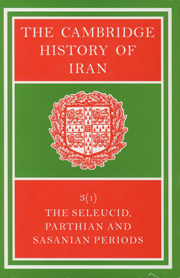Book contents
- Frontmatter
- Introduction
- PART 1 POLITICAL HISTORY
- PART 2 NUMISMATICS
- PART 3 IRANIAN HISTORICAL TRADITION
- PART 4 IRAN AND HER NEIGHBOURS
- 11 Iran and Mesopotamia
- 12 IRAN, ARMENIA AND GEORGIA
- 13 Iran and China
- 14 Cultural Relations between Parthia and Rome
- 15 Byzantium and the Sasanians
- 16 Iran and the Arabs before Islam
- 17 Irano-Turkish Relations in the Late Sasanian Period
- Bibliography
- Plate section
- Plate section
- Plate section
- Map 3. The western regions of the Sasanian empire">
- Map 11. The Silk Road from China to the Roman Orient
- References
11 - Iran and Mesopotamia
from PART 4 - IRAN AND HER NEIGHBOURS
Published online by Cambridge University Press: 28 March 2008
- Frontmatter
- Introduction
- PART 1 POLITICAL HISTORY
- PART 2 NUMISMATICS
- PART 3 IRANIAN HISTORICAL TRADITION
- PART 4 IRAN AND HER NEIGHBOURS
- 11 Iran and Mesopotamia
- 12 IRAN, ARMENIA AND GEORGIA
- 13 Iran and China
- 14 Cultural Relations between Parthia and Rome
- 15 Byzantium and the Sasanians
- 16 Iran and the Arabs before Islam
- 17 Irano-Turkish Relations in the Late Sasanian Period
- Bibliography
- Plate section
- Plate section
- Plate section
- Map 3. The western regions of the Sasanian empire">
- Map 11. The Silk Road from China to the Roman Orient
- References
Summary
In 539 B.C. Cyrus peacefully took possession of Babylon, and the kingdom of Iranian peoples, taken over by the Achaemenian dynasty from the Medes, expanded to become the first real world-empire of ancient history. It is true that the overthrow of Croesus and his Lydian kingdom, sealed by the conquest of Sardis in 546 B.C., had already made the region of Asia Minor subject to the Persians; but it was the thrust down into the southerly regions of the Tigris and Euphrates which gave Cyrus and the Iranian state supranational significance through control of most of the known world. This region was the ancient centre of cuneiform culture which since the third millennium had permeated the whole of the Near East from eastern Anatolia and the Syrian-Palestinian coast to the high valleys of the Zagros mountains and the low-lying plains of Susa. It was here that people from the eastern mountains – Hurrians and Kassites – had already married into the Mesopotamian city and temple culture, setting upon it the stamp of their national idiosyncrasies. This area had from time to time been the arena of political confrontations, in which now Babylonians, now Assyrians had fought for hegemony over the neighbouring peoples. Now Cyrus was pressing into Babylon, as all after him would do whose ambition was to be sole rulers over the east, such as Alexander and the Seleucids, whose historical importance ebbed out only with their loss of Babylon and Assyria to the Arsacids. For the Sasanians, too, the lowlands of Iraq constituted the heart of their dominions, and when this heart finally fell a prey to the onslaught of Muslim armies, their rule over the east likewise was broken.
Keywords
- Type
- Chapter
- Information
- The Cambridge History of Iran , pp. 479 - 504Publisher: Cambridge University PressPrint publication year: 1983



